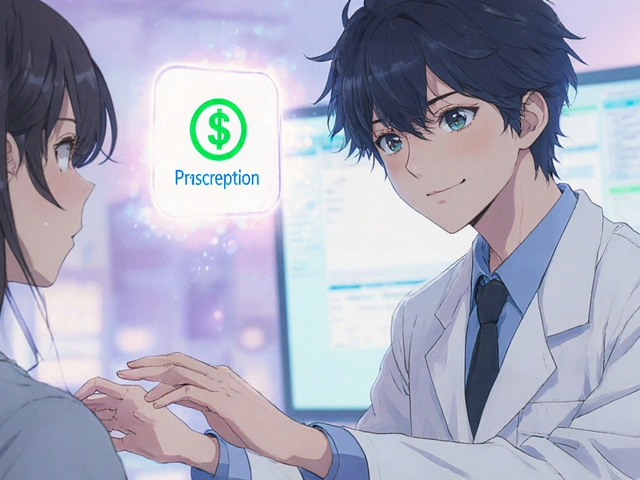TL;DR
- Noroxin is the brand name for norfloxacin, a fluoroquinolone antibiotic once common for UTIs and traveler’s diarrhea. In the U.S. the brand was discontinued; availability varies by country.
- Fluoroquinolones carry serious risks: tendon rupture, nerve damage, mental health effects, blood sugar swings, and rare aortic problems. Most guidelines reserve them for when safer options won’t work.
- Typical adult dosing was 400 mg twice daily, but exact use depends on infection, local resistance, kidney function, and country-specific labels. Don’t self-prescribe.
- Avoid taking with antacids, iron, zinc, or calcium within 2 hours; expect symptom improvement in 24-48 hours. Stop and seek urgent care if you get tendon pain, numbness, severe mood changes, or severe diarrhea.
- Common alternatives for uncomplicated UTIs include nitrofurantoin, TMP‑SMX, fosfomycin, or pivmecillinam (varies by region). Talk to a clinician for the right fit.
What Noroxin is, where it stands in 2025, and when it’s used
If you landed here because you saw Noroxin on an old prescription or heard it mentioned, here’s the short story: Noroxin is norfloxacin, a fluoroquinolone antibiotic. It hits a range of gram‑negative bacteria and concentrates well in urine. That’s why it was used for urinary tract infections (UTIs), some prostate infections, and traveler’s diarrhea.
The catch? Safety concerns changed how we use fluoroquinolones. U.S. FDA Drug Safety Communications (2016 and 2018) highlighted risks like disabling tendon and nerve problems, mental health effects, and dangerous blood sugar swings. The European Medicines Agency (EMA) tightened restrictions in 2019 after a full safety review. Because of this, many countries now reserve norfloxacin and similar drugs for situations where safer antibiotics won’t work.
Availability in 2025:
- United States: The Noroxin brand was discontinued years ago. Norfloxacin itself is rarely used and may be hard to source. Other antibiotics are preferred for most UTIs.
- Europe and many other regions: Use is restricted. Some markets still carry norfloxacin generics, but clinicians often choose alternatives first.
- Travel tip: Names and rules vary by country. Always follow local labeling and your clinician’s advice.
What it’s (sometimes) used for now:
- Uncomplicated UTIs only if first‑line options can’t be used and local resistance patterns support it.
- Some cases of bacterial prostatitis when cultures show susceptibility and other options aren’t suitable.
- Traveler’s diarrhea caused by susceptible bacteria in specific settings, though azithromycin often replaces fluoroquinolones in many regions due to resistance (especially in South/Southeast Asia).
When it’s not the right pick:
- Most routine, uncomplicated UTIs where nitrofurantoin, TMP‑SMX, fosfomycin, or pivmecillinam are effective.
- Viral illnesses like colds or flu-antibiotics don’t help.
- Patients with a history of tendon disorders, aortic aneurysm/dissection, significant peripheral neuropathy, or serious fluoroquinolone reactions.
How it works, in plain language: Norfloxacin blocks bacterial enzymes (DNA gyrase and topoisomerase IV) that bacteria need to copy their DNA. No copying, no survival. In urine, levels get high, which is good for bladder infections. Blood and tissue levels are lower compared with other fluoroquinolones, making it less useful for deep tissue infections.
Resistance reality: In many places, E. coli-the main UTI culprit-shows high resistance to fluoroquinolones. Public surveillance in recent years has reported resistance often above 25% for E. coli in community UTIs in various regions. That’s a big reason guidelines steer away from norfloxacin unless culture results say it’ll work and safer choices won’t.

How to use it safely: dosing, interactions, red flags, and practical checklists
Reading this because you found an old box or your pharmacy offered norfloxacin as a substitute? Pause. Double‑check with a clinician first. Here’s the practical rundown so you can have a focused conversation.
Before starting-quick self‑screen:
- Age over 60, on steroids (like prednisone), or a transplant recipient? Tendon risks are higher-ask for alternatives.
- History of tendon rupture, peripheral neuropathy, myasthenia gravis, or aortic aneurysm/dissection? Avoid fluoroquinolones unless no other option.
- Heart rhythm issues (QT prolongation) or you take QT‑prolonging meds (some antiarrhythmics, antipsychotics, macrolide antibiotics)? Get a clinician’s OK.
- Diabetes on insulin or sulfonylureas? Watch for low blood sugar; have a glucose plan.
- Pregnant, trying to conceive, or breastfeeding? Fluoroquinolones are usually avoided-discuss safer options.
- Kidney disease? Dosing adjustments may be needed.
Typical adult dosing (historical reference-confirm locally):
- Uncomplicated UTI: 400 mg every 12 hours for 3 days (some regions used 5-7 days). Many guidelines now prefer other drugs first.
- Complicated UTI or prostatitis: 400 mg every 12 hours for 10-21 days depending on site and culture results. Other fluoroquinolones (e.g., ciprofloxacin) often have better tissue levels.
- Traveler’s diarrhea (if used): 400 mg every 12 hours for 1-3 days, but azithromycin is often preferred due to resistance patterns.
Dose adjustments: If your estimated creatinine clearance is under ~30 mL/min, many references reduce norfloxacin to 400 mg once daily. Your clinician will tailor this.
How to take it (to avoid absorption problems):
- Empty stomach is best: 1 hour before or 2 hours after meals.
- No minerals around the dose: Keep a 2‑hour buffer before or after iron, zinc, magnesium/aluminum antacids, calcium (including dairy and calcium‑fortified juices), sucralfate, or multivitamins. These bind the drug and block absorption.
- Hydrate well and finish the course unless your clinician tells you to stop for safety reasons.
What you should feel, and when:
- UTI symptoms often ease within 24-48 hours. If not improving by 72 hours, call your clinician to check culture results or switch antibiotics.
- Fever or flank pain (kidney involvement) needs closer follow‑up-don’t wait it out.
Side effects: the common, the serious, and when to call
- Common: nausea, abdominal discomfort, headache, dizziness, trouble sleeping, photosensitivity (sunburns easier).
- Serious-stop and seek care now if you notice: sudden tendon pain/swelling (especially Achilles), tingling/numbness/weakness suggesting nerve issues, new agitation, anxiety, depression, hallucinations, severe confusion, seizures, severe diarrhea (possible C. difficile), chest/back/abdominal pain with a tearing feeling (rare aortic event), severe blood sugar changes (sweats, shakiness, confusion).
Why the emphasis? FDA safety communications in 2016 and 2018 strengthened boxed warnings on fluoroquinolones for disabling tendon and nerve problems, mental health effects, and serious blood sugar disturbances. EMA in 2019 restricted systemic fluoroquinolone use after reviewing long‑lasting, sometimes irreversible side effects. The events are uncommon but serious enough to change prescribing habits.
Drug and food interactions to know:
- Minerals and antacids: Iron, zinc, magnesium/aluminum antacids, calcium, sucralfate, and some multivitamins block absorption. Separate by at least 2 hours before/after.
- Warfarin and other anticoagulants: Possible increased bleeding risk-INR may rise. Monitoring is key.
- Diabetes meds (insulin, sulfonylureas): Risk of hypoglycemia. Keep glucose tabs handy and monitor.
- Theophylline and caffeine: Levels can rise-watch for jitteriness, tremor, nausea.
- Drugs that prolong QT: Some antiarrhythmics (e.g., amiodarone), certain antipsychotics, tricyclic antidepressants, macrolides-ask your prescriber about EKG risk.
- NSAIDs: Rarely, combined CNS stimulation can lower seizure threshold.
- Alcohol: No direct interaction, but go easy-dizziness and blood sugar swings can be worse.
Sun, driving, and day‑to‑day tips:
- Sun: Use sunscreen, protective clothing. Photosensitivity is real.
- Driving/machinery: If you feel dizzy or out of it, don’t drive.
- Missed dose: Take it when you remember unless it’s close to the next dose. Don’t double up.
- Storage: Room temp, dry place, away from kids.
Quick safety checklist you can screenshot:
- Confirm you actually need an antibiotic (urine culture if possible).
- List your meds and conditions; ask about interactions.
- Take on an empty stomach; separate from minerals by 2 hours.
- Stop and seek help for tendon pain, numbness, severe mood changes, severe diarrhea, or chest/back pain.
- If not better in 48-72 hours, call your clinician.
| Antibiotic (common use) | Typical adult regimen | Best for | Key cautions | Pregnancy |
|---|---|---|---|---|
| Nitrofurantoin (UTI) | 100 mg twice daily for 5 days | Uncomplicated cystitis | Avoid if CrCl <30 mL/min; not for pyelonephritis | Often acceptable in 2nd-3rd trimester |
| TMP‑SMX (UTI) | 160/800 mg twice daily for 3 days | Uncomplicated cystitis (if local resistance low and no sulfa allergy) | Check for allergies; watch potassium, interactions (e.g., warfarin) | Generally avoided near term |
| Fosfomycin (UTI) | 3 g single dose (sachet) | Uncomplicated cystitis | May be less effective if resistance high; some recurrence risk | Often acceptable |
| Pivmecillinam (UTI) | 400 mg 3-4× daily for 3-5 days | Uncomplicated cystitis (Europe, others) | GI upset; not available everywhere | Often acceptable |
| Norfloxacin (Noroxin) | 400 mg twice daily, 3-7 days (UTI); longer for prostatitis | Consider only when safer options unsuitable and cultures susceptible | Boxed‑warning class risks: tendon, nerve, CNS, glucose, rare aortic events | Generally avoided |
| Ciprofloxacin (fluoroquinolone) | 250-500 mg twice daily (varies) | Complicated UTIs, prostatitis when indicated | Same class warnings; many interactions | Generally avoided |
| Azithromycin (traveler’s diarrhea) | 1 g once or 500 mg daily for 1-3 days | TD in regions with high FQ resistance | QT risk in predisposed patients | Often acceptable |

Smarter choices: when to pick alternatives, FAQs, and what to do next
Choosing the right antibiotic is about matching the bug, the body, and the risks. Here are quick scenarios and better‑fit options to discuss with your clinician.
Uncomplicated bladder infection (non‑pregnant adult):
- Often first‑line: nitrofurantoin 5 days, fosfomycin once, or TMP‑SMX 3 days (if resistance is low and no sulfa allergy). Pivmecillinam is another option in many countries.
- Why not norfloxacin? Safety profile and resistance. Use only if cultures support it and others won’t work.
Kidney infection (pyelonephritis) symptoms-fever, flank pain, vomiting:
- Get medical care. You’ll likely need a different antibiotic with better tissue levels, sometimes IV at first.
Prostatitis:
- Antibiotics need good prostate penetration. Ciprofloxacin or levofloxacin are often used if the bacteria are susceptible, but the same class warnings apply. Alternatives depend on cultures and tolerance.
Traveler’s diarrhea:
- In many regions, azithromycin is now preferred due to resistance to fluoroquinolones. Hydration matters more than anything.
Pregnancy or breastfeeding:
- Fluoroquinolones are usually avoided. Safer options exist for UTIs in pregnancy. If breastfeeding and a fluoroquinolone is unavoidable, some guidelines allow it with monitoring for infant GI upset-talk this through with your clinician.
Athlete or very active person:
- Tendon risk is a big deal. If you must use a fluoroquinolone, rest high‑stress tendons during treatment and for several days after.
Mini‑FAQ
- Can I drink alcohol on norfloxacin? Moderate alcohol doesn’t directly interact, but skip it if you feel dizzy or have blood sugar swings.
- Does it mess with birth control pills? No known effect like rifampin has. Use backup for GI upset (vomiting/diarrhea) since that can reduce pill absorption.
- How fast will I feel better? Often within 1-2 days for UTIs. No improvement by day 3? Call your clinician.
- Do I need a urine culture? It’s ideal, especially if you’ve had recent antibiotics, recurrent UTIs, or severe symptoms.
- What if I miss a dose? Take it when you remember unless it’s close to the next dose. Don’t double up.
- Sun safety? Yes-use sunscreen and cover up; photosensitivity can bite.
- Can it cause C. diff diarrhea? Yes. Watery, persistent, or bloody diarrhea-seek care.
What to ask your clinician or pharmacist
- Given my allergies and meds, what’s the safest first‑line antibiotic for me?
- Do local resistance patterns support this choice?
- If I must use a fluoroquinolone, how do we monitor for tendon, nerve, and glucose side effects?
- How should I space this from my supplements?
- When should I call you or go to urgent care?
Next steps and troubleshooting
- If you already started norfloxacin and feel tendon pain, numbness/tingling, severe mood changes, or severe diarrhea: stop the drug and get urgent medical advice. The earlier you act, the better.
- If symptoms aren’t improving after 48-72 hours: call for a recheck and culture results. You may need a different antibiotic.
- If your pharmacy can’t source norfloxacin: ask for guideline‑preferred alternatives based on your case and local resistance.
- Chronic kidney disease: verify dosing. Ask if nitrofurantoin is appropriate (depends on your kidney function) or if another option is safer.
- Diabetes on insulin/sulfonylureas: check sugars more often. Keep fast‑acting carbs nearby.
- History of aneurysm or significant vascular disease: discuss non‑fluoroquinolone choices.
- On steroids or age 60+: tendon risk is higher-strongly consider alternatives.
Credibility notes
The safety points here reflect FDA Drug Safety Communications from 2016 (updated boxed warnings on disabling side effects) and 2018 (mental health and blood glucose effects), plus the EMA’s 2019 restrictions on systemic fluoroquinolones after reviewing long‑lasting side effects. Current UTI treatment preferences also follow major guideline trends that emphasize nitrofurantoin, TMP‑SMX, fosfomycin, or pivmecillinam first, depending on local resistance and patient factors.
Bottom line: Norfloxacin still exists in some places, but for many people there’s a safer, equally effective option. Bring your symptoms, meds, and history to a clinician who knows your local resistance patterns, and pick the right drug the first time.







AARON HERNANDEZ ZAVALA
September 20, 2025 AT 07:09Just say no unless you're out of options.
Lyn James
September 20, 2025 AT 13:49Craig Ballantyne
September 21, 2025 AT 16:19Victor T. Johnson
September 21, 2025 AT 22:29Nicholas Swiontek
September 23, 2025 AT 03:58Robert Asel
September 24, 2025 AT 08:15Shannon Wright
September 26, 2025 AT 05:06Ben Wood
September 26, 2025 AT 20:25Sakthi s
September 28, 2025 AT 17:49Rachel Nimmons
September 29, 2025 AT 03:08